Stock market today: Nasdaq closes above 23,000 for first time as tech rebounds
FILA Fabbrica Italiana Lapis ed Affini SpA (BIT:FILA) released its H1 2025 results presentation on August 6, showing declining revenue and profits amid challenging market conditions, particularly in the United States. Despite these headwinds, the company maintained relatively stable margins through cost containment efforts and improved its leverage position.
Introduction & Market Context
FILA’s shares declined 2.06% to €8.55 following the presentation, as investors digested the impact of ongoing macroeconomic challenges and tariff uncertainties on the company’s performance. The art supplies manufacturer, which celebrated its 105th anniversary this year, has faced increasing pressure in key markets after showing initial resilience in Q1 2025.
The company’s H1 results reflect a significant deterioration in the second quarter, contrasting with the modest growth reported in Q1. While Q1 showed revenue growth of 3.4% year-over-year, the combined H1 results revealed a 5.6% decline, indicating a substantial downturn in Q2 performance.
As shown in the following summary of key H1 2025 highlights:
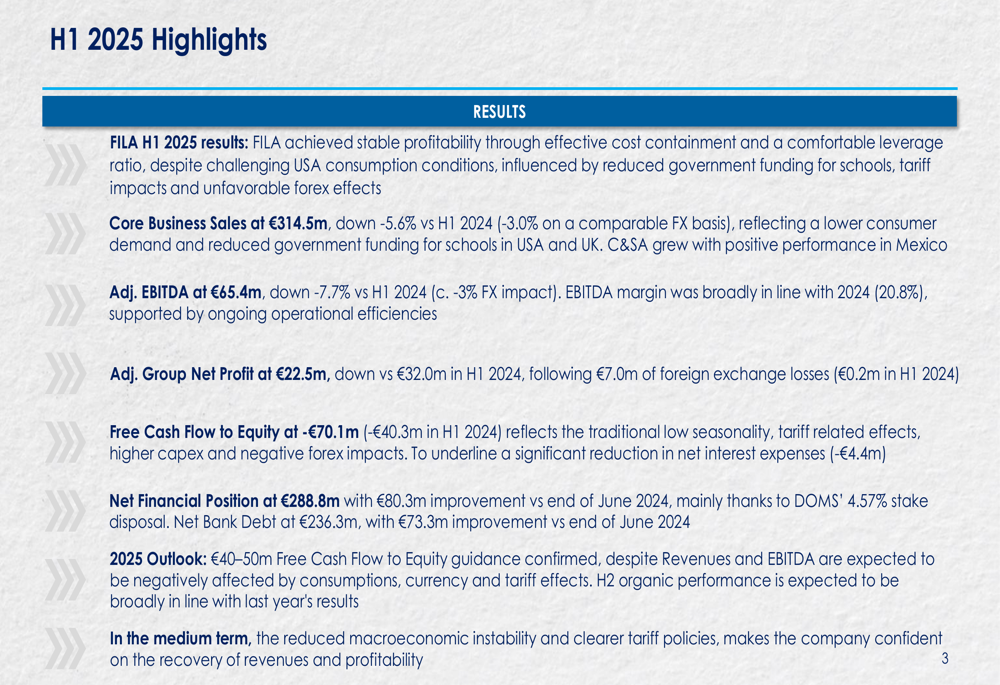
Quarterly Performance Highlights
FILA reported core business sales of €314.5 million for H1 2025, down 5.6% compared to H1 2024, or 3.0% lower on a comparable exchange rate basis. Adjusted EBITDA fell 7.7% to €65.4 million, with approximately 3% of this decline attributed to foreign exchange impacts. Despite these challenges, the company maintained a relatively stable EBITDA margin of 20.8%, compared to 21.3% in the same period last year.
Adjusted group net profit declined more significantly, falling to €22.5 million from €32.0 million in H1 2024. This steeper drop was primarily due to €7.0 million in foreign exchange losses, compared to just €0.2 million in the prior year period.
The following snapshot provides a comprehensive view of H1 2025 results compared to the previous year:
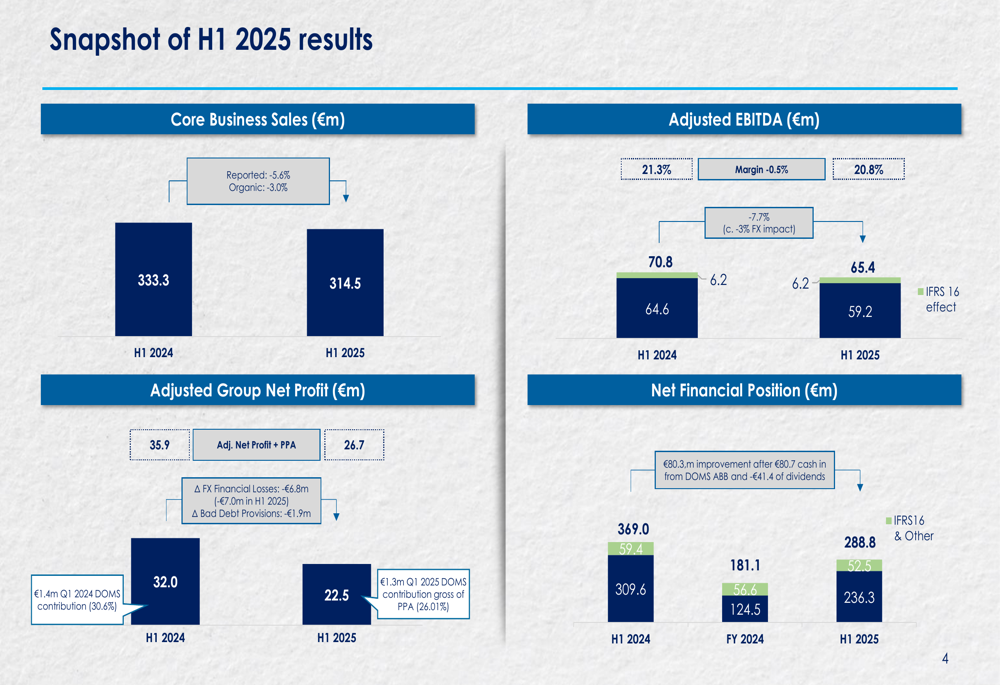
Despite the current challenges, FILA has demonstrated consistent long-term growth, with a 1.9% CAGR in core business sales and a 3.2% CAGR in adjusted EBITDA from FY2020 to FY2024. The company has generated over €240 million in cumulative free cash flow to equity during this period.
The multi-year performance trends are illustrated in the following chart:
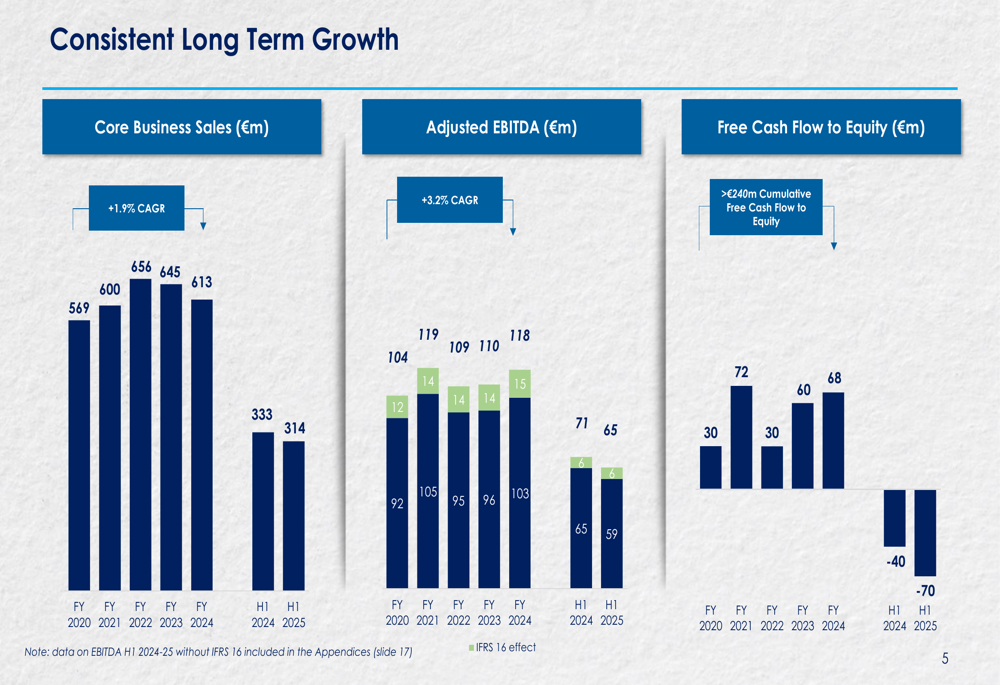
Regional Performance Analysis
FILA’s revenue decline was broad-based across most regions, with North America and Europe—the company’s largest markets—both experiencing sales contractions. North America, which accounts for 49% of total sales, saw revenues fall 5.2% to €155.0 million, or 4.0% on a comparable exchange rate basis. This aligns with management’s comments from the Q1 earnings call about the US market softening since March.
Europe, representing 36% of sales, experienced a 3.7% decline to €113.2 million. Central and South America showed the largest percentage drop at 10.7%, though when adjusted for currency effects, this region actually grew by 4.3%.
The regional sales breakdown is detailed in the following chart:
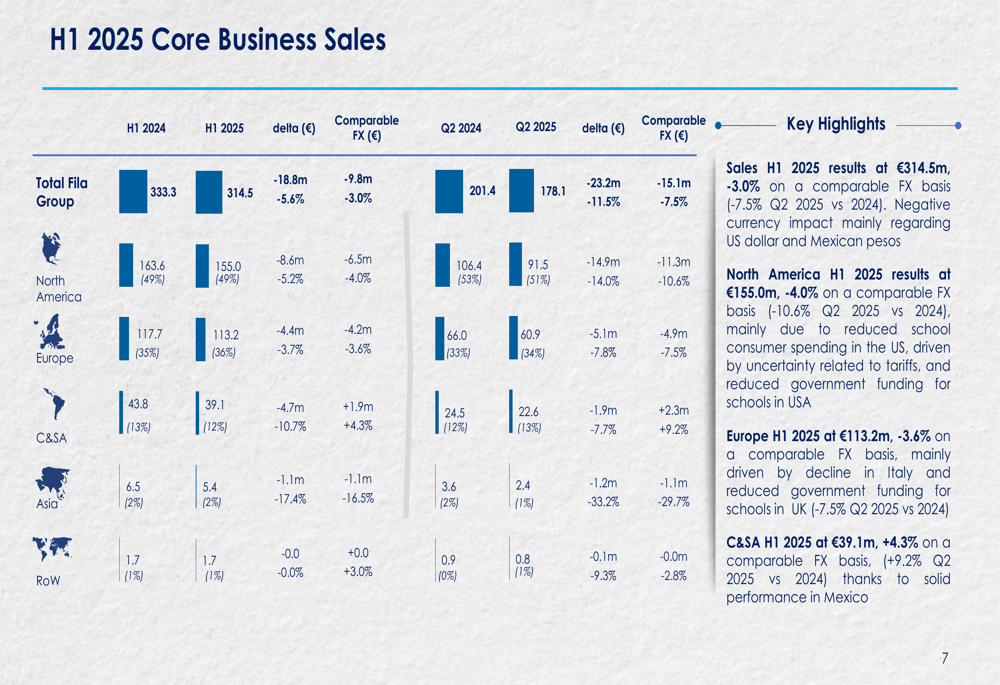
From a profitability perspective, all major regions except Asia and Rest of World saw EBITDA declines. North America’s adjusted EBITDA fell 9.0% to €34.4 million, while Europe’s decreased 5.4% to €20.4 million. Despite these declines, EBITDA margins remained relatively stable across regions, demonstrating FILA’s ability to manage costs effectively in a challenging environment.
The regional EBITDA performance is illustrated here:
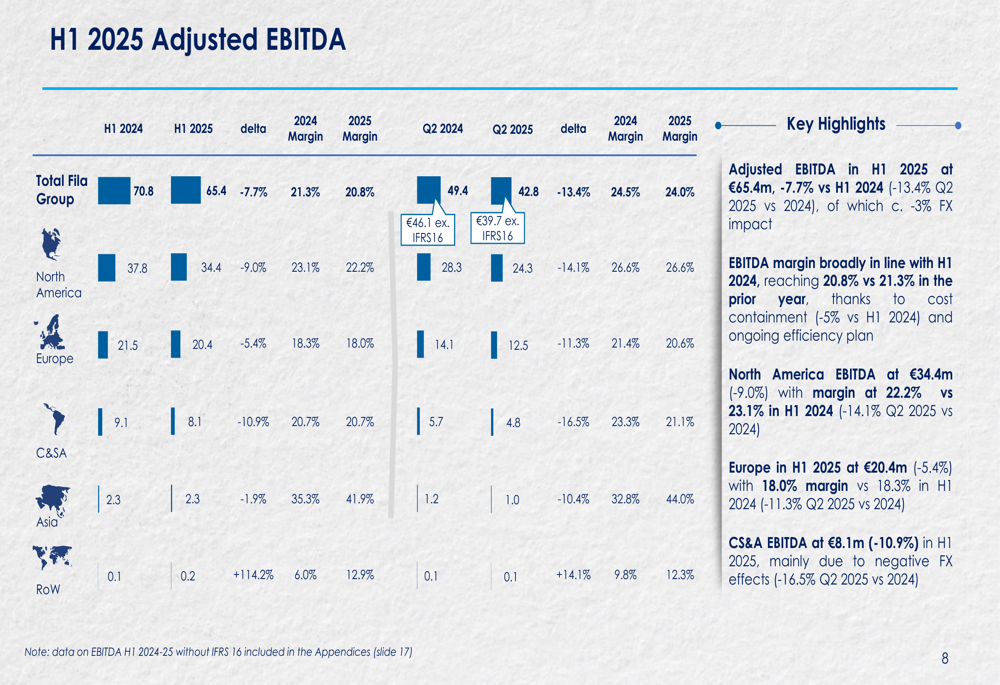
Financial Position and Debt Management
FILA’s free cash flow to equity was negative €70.1 million in H1 2025, compared to negative €40.3 million in H1 2024. This decline reflects the customary seasonal outflow for working capital, with net working capital absorption reaching €96.6 million. Capital expenditures totaled €9.1 million, while tax payments and net financial expenses were €4.4 million and €6.4 million, respectively.
Despite the negative free cash flow, FILA improved its net financial position, which stood at €288.8 million at the end of H1 2025, representing an €80.3 million improvement compared to the end of June 2024. This improvement was primarily due to €80.7 million in cash proceeds from the partial sale of FILA’s stake in DOMS Industries, offset by €41.4 million in dividend payments.
The company’s leverage ratio improved to 2.1x net bank debt to LTM adjusted EBITDA, down from 2.7x in H1 2024. This improvement provides FILA with greater financial flexibility to navigate the current challenging market environment.
The debt and leverage metrics are summarized in the following chart:
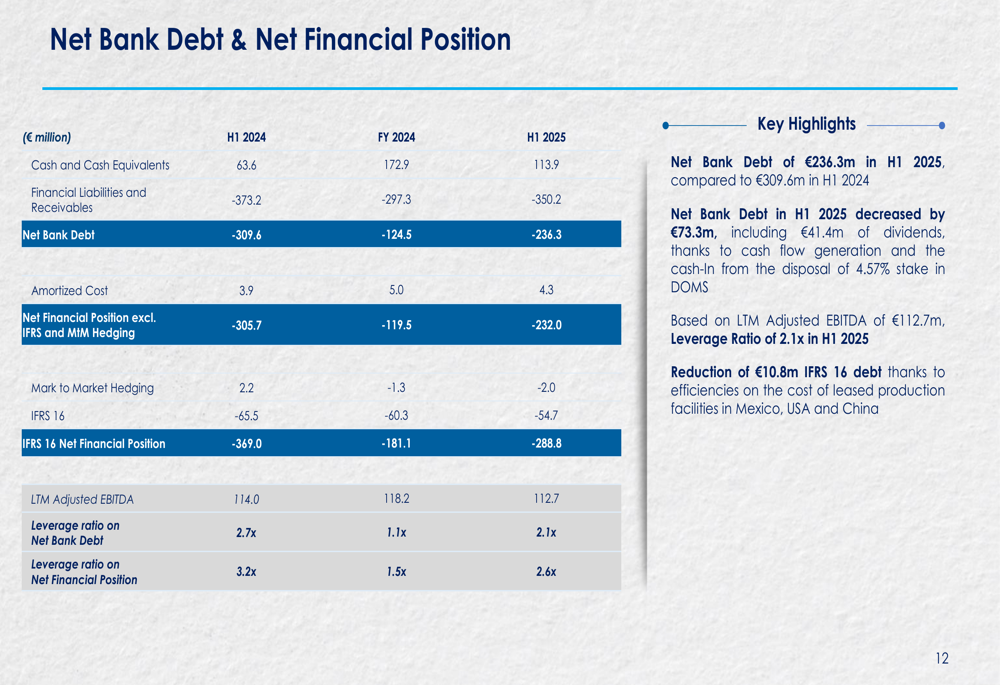
DOMS Industries Investment Value
FILA’s 26.01% stake in DOMS Industries, an Indian stationery and art supplies manufacturer, represents a significant asset valued at €376.76 million based on DOMS’ market capitalization of 147.23 billion Indian rupees as of August 5, 2025. DOMS continues to show strong growth potential, with consensus estimates projecting sales to increase from 19,126 million rupees in 2025 to 33,388 million rupees by 2028, representing a compound annual growth rate of approximately 20%.
The value and growth prospects of FILA’s DOMS investment are detailed here:
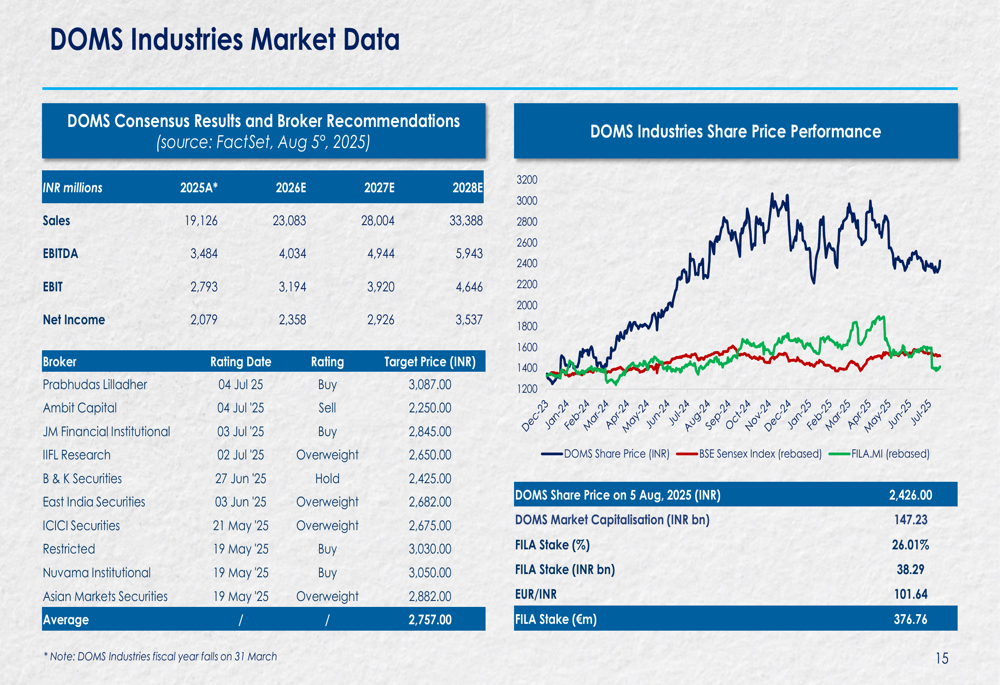
Forward-Looking Statements
Despite the challenging first half, FILA confirmed its 2025 guidance for free cash flow to equity of €40-50 million. The company expects its H2 organic performance to be broadly in line with last year’s results, suggesting a stabilization of business conditions.
Looking to the medium term, management expressed confidence in the recovery of revenues and profitability, citing expectations of reduced macroeconomic instability and clearer tariff policies. This outlook aligns with comments made during the Q1 earnings call, where executives noted they were maintaining guidance despite market uncertainties.
FILA’s ability to maintain relatively stable margins despite revenue pressure demonstrates the company’s operational resilience. However, the significant deterioration in performance from Q1 to H1 highlights the increasing challenges in the company’s key markets, particularly the United States. Investors will be watching closely to see if the anticipated stabilization in the second half materializes as projected.
Full presentation:
This article was generated with the support of AI and reviewed by an editor. For more information see our T&C.
